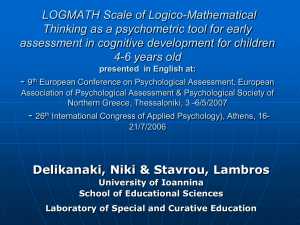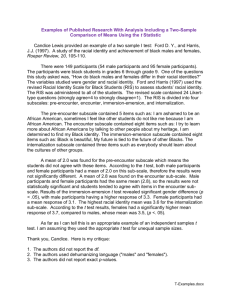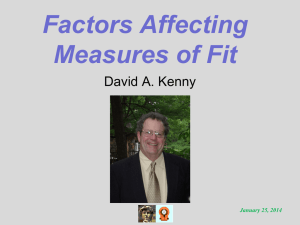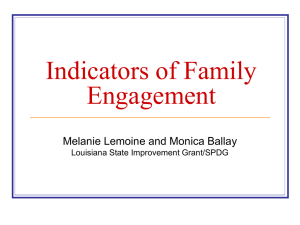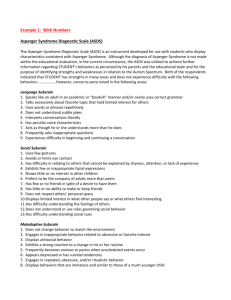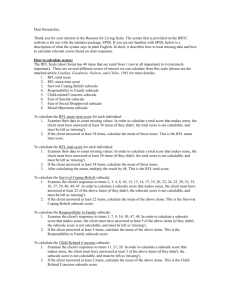View/Open - Lirias
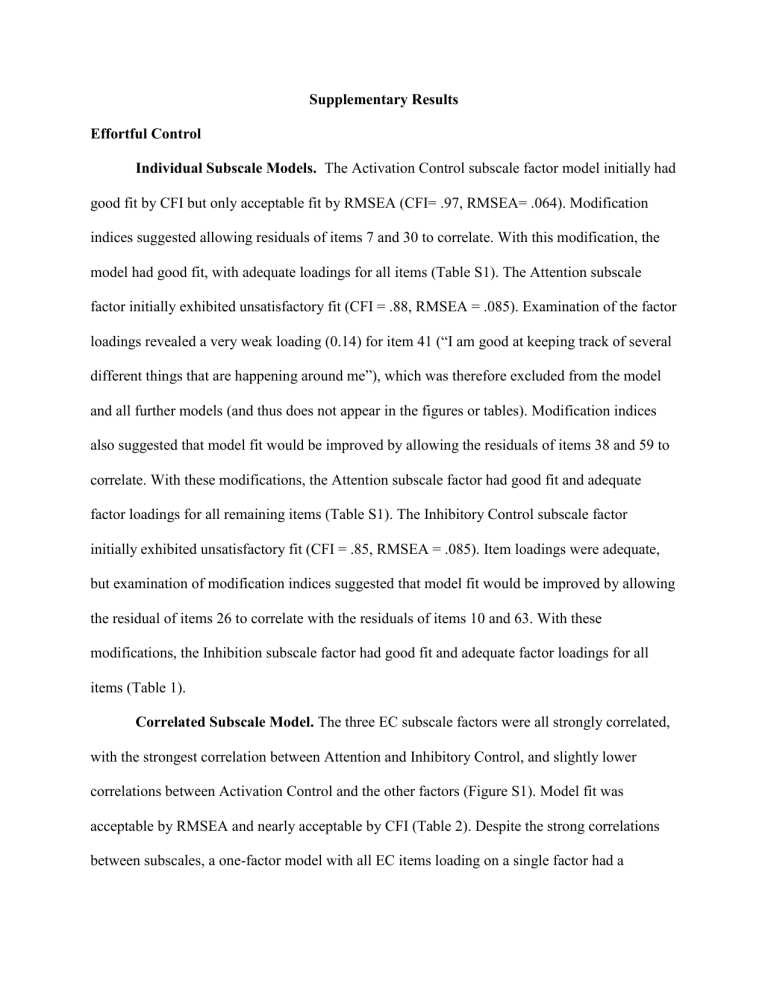
Supplementary Results
Effortful Control
Individual Subscale Models. The Activation Control subscale factor model initially had good fit by CFI but only acceptable fit by RMSEA (CFI= .97, RMSEA= .064). Modification indices suggested allowing residuals of items 7 and 30 to correlate. With this modification, the model had good fit, with adequate loadings for all items (Table S1). The Attention subscale factor initially exhibited unsatisfactory fit (CFI = .88, RMSEA = .085). Examination of the factor loadings revealed a very weak loading (0.14) for item 41 (“I am good at keeping track of several different things that are happening around me”), which was therefore excluded from the model and all further models (and thus does not appear in the figures or tables). Modification indices also suggested that model fit would be improved by allowing the residuals of items 38 and 59 to correlate. With these modifications, the Attention subscale factor had good fit and adequate factor loadings for all remaining items (Table S1). The Inhibitory Control subscale factor initially exhibited unsatisfactory fit (CFI = .85, RMSEA = .085). Item loadings were adequate, but examination of modification indices suggested that model fit would be improved by allowing the residual of items 26 to correlate with the residuals of items 10 and 63. With these modifications, the Inhibition subscale factor had good fit and adequate factor loadings for all items (Table 1).
Correlated Subscale Model. The three EC subscale factors were all strongly correlated, with the strongest correlation between Attention and Inhibitory Control, and slightly lower correlations between Activation Control and the other factors (Figure S1). Model fit was acceptable by RMSEA and nearly acceptable by CFI (Table 2). Despite the strong correlations between subscales, a one-factor model with all EC items loading on a single factor had a
significantly worse fit than the full three-factor model (
2 (3) = 159.94, p <.001), suggesting that EC cannot be reduced to a single latent construct.
Negative Emotionality
Individual Subscale Models. The Aggression subscale factor model had good fit, with adequate loadings for all items (Table 1). The Depressed Mood (CFI = .94, RMSEA = .086),
Fear (CFI = .92, RMSEA = .088), Frustration (CFI = .92, RMSEA = .074) and Shyness (CFI =
.99, RMSEA = .054) subscale factors initially exhibited acceptable but not good fit. Item loadings were adequate, but examination of modification indices suggested that model fit would be improved by allowing some of the residual variances within each subscale to be correlated: item 37 with item 20 and 29 for Depressed Mood, item 51 with items 32 and 35 for Fear, item 60 with item 64 for Frustration, and item 45 with item 53 for Shyness. With these modifications, the factors all had good fit and adequate factor loadings for all items (Table S1).
Correlated Subscale Model. Correlations were strongest between Depressed Mood and
Fear and between Aggression and Frustration, while Aggression correlated only weakly with
Shyness and Fear, and Shyness correlated only weakly with Frustration (Figure S2). All other correlations were moderate (Figure S2). Model fit was good by RMSEA and nearly acceptable by CFI (Table 2). Model fit was significantly better than for a one factor-model (
2
(10) =
1200.82, p <.001), suggesting that NEM cannot be reduced to a single latent construct.
NEM Models Excluding Aggression and Depressed Mood. Given disagreement in the literature as to whether the Aggression and Depressed Mood subscales should be included in the
NEM model, we also tested NEM models that only included the Fear, Frustration and Shyness subscales. The decision as to whether to include the Aggression and Depressed Mood subscales will depend on the hypotheses of interest. If item overlap with other specific measures of
depression or aggression is a concern for a particular study, excluding these subscales from NE may be appropriate and make sense. In addition, these subscales were originally considered separate measures of social/emotional functioning (Ellis & Rothbart, 2001). However, it should be noted that excluding these two subscales does not eliminate all overlap with psychopathology, given that the Fear subscale contains items related to anxiety disorders. In general, given the close conceptual and empirical links between NE and psychopathology (e.g., Lahey, 2009), it is not clear that attempting to eliminate overlap between them is practicable or desirable.
Moreover, depressed mood and aggression/hostility are generally considered core components of
NE, and are included in other temperament/personality measures (e.g., Capaldi & Rothbart,
1992; Costa & McCrae, 1995; Evans & Rothbart, 2007; Rothbart, Ahadi, Hershey, & Fisher,
2001). Thus, including the Depressed Mood and Aggression subscales provides better coverage of the full range of negative emotions generally considered to be aspects of NE.
For the correlated subscale model, the Fear factor correlated moderately with the
Frustration and Shyness factors, while Frustration and Shyness were only weakly correlated
(Figure S1). Model fit was good by RMSEA and acceptable by CFI (Table 2). Model fit for this three-factor model was significantly better than for a one factor-model (
2 (1) = 384.03, p
<.001), suggesting that these three NEM subscales cannot be reduced to a single latent construct.
The initial version of the bifactor model demonstrated that there was no significant variance associated with the Fear-specific factor, but there was significant variance for the
Frustration-specific and Shyness-specific factors. We therefore modified the model to eliminate the Fear-specific factor (Figure S2). Model fit was good (Table 2). Model fit was significantly better than both the one factor model (
2
(9) = 487.33, p <.001) and the correlated three factor model (
2
(8) = 103.3 p <.001).
Positive Emotionality
Individual Subscale Models. The Pleasure Sensitivity and Perceptual Sensitivity subscale factor models had good fit, with adequate loadings for all items (Table 1). The
Affiliation factor model initially exhibited acceptable but not good fit (CFI = .94, RMSEA =
.079). Item loadings were adequate, but examination of modification indices suggested that model fit would be improved by allowing the residual variances of items 31 and 54 to correlate.
With this modification, the Affiliation subscale factor model had good fit (Table 1). The
Surgency subscale factor initially exhibited unsatisfactory fit (CFI = .89, RMSEA = .093).
Examination of the factor loadings revealed a very weak loading for item 3 (“I think it would be exciting to move to a new city”, loading = 0.11) and item 19 (“I wouldn’t like living in a big city even if it was safe,” reversed, loading = .17), which were therefore excluded from the model and all further models. Modification indices also suggested that model fit would be improved by allowing the residuals of items 38 and 59 to correlate. With these modifications, the Surgency subscale factor had good fit and adequate factor loadings for all remaining items (Table 1).
Correlated Subscale Model. Affiliation, Pleasure Sensitivity and Perceptual Sensitivity were all weakly to moderately correlated, whereas Surgency was only very weakly correlated with any of the other subscales (Figure 5). Model fit was acceptable by RMSEA and nearly acceptable by CFI (Table 2). Model fit was significantly better than for a one-factor model (
2
(18) = 1185.61, p <.001), suggesting that PEM cannot be reduced to a single latent construct.
Figure S1. Correlated subscale model of Effortful Control. Numbers in boxes are EATQ-R item numbers; (R) indicates that the item is reverse coded. Numbers on straight arrows are factor loadings. Numbers on curved arrows between factors are latent correlations. Curved arrows between item boxes indicate model modifications allowing the residual variance of the items to correlate.
Figure S2. Correlated subscale model of Negative Emotionality. Numbers in boxes are EATQ-R item numbers; (R) indicates that the item is reverse coded. Numbers on straight arrows are factor loadings. Numbers on curved arrows between factors are latent correlations. Dashed lines indicate weak correlations <.30, and solid lines represent stronger correlations. Curved arrows between item boxes indicate model modifications allowing the residual variance of the items to correlate.
Figure S3. 3-factor correlated subscale model of Negative Emotionality excluding Aggression and Depressed Mood. Numbers in boxes are EATQ-R item numbers; (R) indicates that the item is reverse coded. Numbers on straight arrows are factor loadings. Numbers on curved arrows between factors are latent correlations. Dashed lines indicate weak correlations <.30, and solid lines represent stronger correlations. Curved arrows between item boxes indicate model modifications allowing the residual variance of the items to correlate.
Figure S4. Bifactor model for Negative Emotionality excluding Aggression and Depressed
Mood. The Common NEM factor captures what is shared across all NEM items, while the each specific factor captures what is unique to the items in that subscale. Numbers in boxes are
EATQ-R item numbers; (R) indicates that the item is reverse coded. Numbers on straight arrows are factor loadings. Curved arrows between item boxes indicate model modifications allowing the residual variance of the items to correlate.
Figure S5. Full 4-factor correlated subscale model of Positive Emotionality. Numbers in boxes are EATQ-R item numbers; (R) indicates that the item is reverse coded. Numbers on straight arrows are factor loadings. Numbers on curved arrows between factors are latent correlations.
Dashed lines indicate weak correlations <.30, and solid lines represent stronger correlations.
Curved arrows between item boxes indicate model modifications allowing the residual variance of the items to correlate.
Table S1
Demographics and Descriptive Statistics By Sample
Demographics n
Age: Mean
(SD)
Gender: %
Female
Ethnicity
EATQ-R
Subscale Means
(SD)
Sample
Recruited
From
University of
Denver Sample
294
13.61 (2.18)
54%
75% White, 12%
African American,
5% Asian, and 8% more than one race; 15% of participants identified as
Hispanic
61% White, 16%
African American,
15% Asian, and
4% more than one race; 8% of participants identified as
Hispanic
Public schools in the Denver, CO metro area
Public schools in the New
Brunswick, NJ metro area
15.86 (3.86)
Primarily white;
11% originated from a non-
Western country
(mostly Morocco,
Turkey, Surinam, the Dutch
Antilles, and
Indonesia)
Five municipalities in the north of The
Netherlands, including both urban and rural areas
16.34 (3.10) Activation
Control
Attention
16.66 (4.10)
Inhibitory
Control
21.16 (3.65)
19.60 (2.83)
Aggression 10.68 (3.49)
Depressed 12.89 (4.02)
Mood
Fear 12.77 (3.94)
Frustration 19.45 (4.72)
Shyness 9.49 (3.53)
Rutgers
University Sample
242
15.30 (2.46)
56%
20.97 (3.51)
18.87 (3.12)
11.69 (4.45)
13.68 (4.54)
13.18 (4.19)
20.67 (4.88)
9.23 (3.88)
TRAILS Sample KU Leuven
Adolescent
Sample
340 1
10.52 (0.62)
307
16.09 (1.23)
44%
21.40 (3.54)
18.06 (2.98)
13.24 (4.27)
13.21 (4.38)
13.88 (4.49)
20.38 (5.07)
9.84 (3.62)
68%
Primarily white
Belgian secondary schools
14.30 (3.99)
20.61 (3.35)
17.88 (2.84)
14.75 (4.63)
14.26 (4.60)
14.26 (4.25)
22.03 (4.13)
10.19 (4.03)
KU Leuven Child
Sample
588
12.10 (2.21)
57%
Primarily white
Belgian primary and secondary schools
15.69 (3.89)
20.93 (3.45)
17.38 (3.07)
13.64 (4.24)
14.36 (4.19)
15.15 (4.60)
21.12 (4.36)
10.60 (3.63)
Seattle Pacific
University Sample
256
12.26 (0.99)
61%
79% White, 2%
African American,
5% Asian, and 8% more than one race; 3% of participants identified as
Hispanic
Public and private middle schools in the Seattle, WA metro area
17.66 (3.82)
21.15 (3.38)
18.83 (3.06)
Not administered
Not administered
15.74 (4.74)
21.13 (4.92)
9.59 (3.65)
Affiliation
Perceptual
Sensitivity
Pleasure
Sensitivity
Surgency
17.86 (3.62)
13.02 (3.37)
16.90 (4.44)
18.15 (3.64)
12.70 (3.54)
15.30 (4.43)
18.43 (3.61)
12.00 (3.37)
14.96 (4.73)
20.51 (2.60)
13.32 (2.68)
14.44 (4.14)
19.51 (2.92)
13.04 (2.78)
15.95 (4.27)
Not administered
Not administered
Not administered
20.47 (4.21) 20.19 (4.37) 19.18 (4.09) 19.76 (4.59) 18.83 (4.40) 18.86 (4.22)
1 A random subsample of 340 participants (out of N=2230) was selected from the total sample to match the mean number in the other datasets, so that each dataset has approximately equal weight in the analyses.
Table S2
Individual Subscale Factors
Subscale Descriptio n a
Item Item Text
Activation Control Begin and complete tasks when there is a strong tendency to avoid it.
Attention
Inhibitory Control
Focus and sustain attention as well as to shift attention when desired.
Suppress or stop inappropri ate behaviors, wait & plan before acting.
39
49
(R)
1
34
(R)
38
(R)
59
61
(R)
10
(R)
14
26
(R)
43
63
Aggression Hostile reactivity and aggressive physical and verbal actions.
7 (R) I have a hard time finishing things on time.
18
(R)
I do something for awhile before starting my homework, even when I’m not supposed to.
30 If I have a hard assignment to do, I get started right away.
5
9
13
22
I finish my homework before the due date.
I put off working on projects until right before they’re due.
It is easy for me to really concentrate on homework problems.
I find it hard to shift gears when I go from one class to another at school.
When trying to study, I have difficulty tuning out background noise and concentrating.
I pay close attention when someone tells me how to do something.
I tend to get in the middle of one thing, then go off and do something else.
It’s hard for me not to open presents before I’m supposed to.
When someone tells me to stop doing something, it is easy for me to stop.
The more I try to stop myself from doing something I shouldn’t, the more likely I am to do it.
It’s easy for me to keep a secret.
I can stick with my plans and goals.
If I’m mad at somebody, I tend to say things that I know will hurt their feelings.
When I am angry, I throw or break things.
If I really get mad at someone, I might hit them.
I tend to be rude to people I don’t like.
0.65
0.76
0.76
0.64
0.51
0.62
0.32
0.61
0.54
0.44
0.31
0.45
0.56
0.35
0.49
0.59
0.68
0.80
0.67
50
58
When I’m really mad at a friend, I tend to explode to them.
I pick on people for no real reason.
0.71
0.33
Loadin g
SE Residu al
Varian ce
0.07
1
0.04
5
0.06
0
0.03
6
0.04
1
0.04
4
0.04
1
0.03
9
0.03
9
0.03
9
0.03
3
0.04
1
0.03
3
0.03
6
0.06
8
0.05
2
0.04
0
0.04
0
0.04
1
0.04
4
0.94
0.76
0.68
1.24
0.90
0.61
0.90
0.63
0.70
0.81
1.80
0.87
0.86
0.86
0.68
0.69
0.88
0.95
0.88
0.75
0.02
0.50
Item
Mea n
Ite m
SD
2
(df)
3.63
3.02
3.08
2.96
3.24
3.45
4.13
3.03
3.60
3.47
3.54
3.45
3.69
4.07
3.51
2.72
1.71
2.32
2.33
2.42
1.52
1.0
9
0.9
9
0.9
6
1.2
6
1.1
5
1.1
2
0.7
1.1
6
1.0
2
1.2
2
0.9
6
1.0
7
1.1
6
1.0
1
0.9
9
1.3
8
1.0
4
1.0
8
1.2
8
1.1
2
1.1
7
8.98
(4)
7.92
(4)
3.85
(3)
23.84
(9)**
1.9
8
1.2
8
2.6
5
2
/df
2.2
5
CF
I
RMSE
A
.99 .035
.99
1
.99
.031
.017
.043
Depressed Mood Lowered mood, loss of enjoyment and interest in activities.
2 (R) I feel pretty happy most of the day.
11
20
29
My friends seem to enjoy themselves more than I do.
It often takes very little to make me feel like crying.
I get sad more often than people realize.
Fear
Frustration
Shyness
Anticipatio n of distress, including worry and fear.
Negative affect related to interruptio n of ongoing tasks or goal blocking.
37
55
32
35
40
46
51
57
25
36
47
56
60
62
I get sad when a lot of things are going wrong.
I feel sad even when I should be enjoying myself, like at Christmas or on a trip.
I get frightened when riding with a person who likes to speed.
I worry about my family when I’m not with them.
0.52
0.57
0.60
0.63
I worry about getting into trouble.
I am nervous of some kids at school who push people into lockers and throw your books
I worry about my parent(s) dying or leaving me.
0.65
0.59
0.74
I feel scared when I enter a darkened room at home.
It bothers me when I try to make a phone call and the line is busy.
I get very upset when I try to do something and my parents won’t let me.
I get irritated when I have to stop doing something that I am enjoying.
I really annoys me to wait in long lines.
I get very frustrated when I make a mistake in my school work.
It frustrates me if people interrupt me when I’m talking.
I get upset if I’m not able to do a task really well.
I feel shy with kids of the opposite sex.
0.63
0.61
0.62
0.59
0.62
0.39
0.65
0.45
0.69
0.55
0.88
0.52
0.52
Perceptual
Sensitivity
Behavioral inhibition to novelty and challenge, especially social.
Awareness of slight,
64
8
15
45
53
(R)
6
I feel shy about meeting new people.
I am shy.
I am not shy.
I notice even little changes taking place around me, like lights getting brighter in a room.
0.82
1.00
0.89
0.74
9
0.03
2
0.04
0.04
1
0.04
6
0.04
8
0.04
0.04
4
0.04
2
0.04
1
0.03
6
0.04
0
0.04
8
0.04
3
0.04
2
0.04
7
0.05
3
0.04
0
0.03
7
0.03
8
0.03
7
0.04
4
0.04
7
0.05
5
0.04
6
0.55
0.75
0.90
0.78
1.14
0.82
1.21
0.89
0.92
1.30
1.21
1.05
1.06
0.96
0.74
0.93
1.05
0.71
0.91
0.93
0.68
0.39
0.30
0.89
1.96
2.20
2.14
2.51
2.96
2.02
2.40
2.28
2.53
2.35
2.56
2.33
2.68
3.00
3.14
3.14
2.67
3.33
2.89
2.18
2.71
2.42
2.74
3.34
8
1.1
0
1.0
6
1.0
9
1.1
0
6
1.0
4
1.1
5
1.2
1
1.2
0
1.1
6
1.2
8
1.3
3
1.2
6
1.1
3
1.1
5
1.2
0
1.0
7
0.8
7
1.1
0
1.1
0
1.2
1.1
6
1.1
7
1.2
9
1.2
0
22.75
(7)**
17.79
(7)*
33.46
(13)*
*
2.81
(1)
5.70
(2)
3.2
6
2.5
4
2.5
7
2.8
1
2.8
5
.99 .05
.99
.98
1
.99
.039
.039
.042
.045
Pleasure
Sensitivity
Affiliation lowintensity stimulation in the environme nt.
Pleasure related to activities or stimuli involving low intensity.
The desire for warmth and closeness with others.
12
21
24
4
16
23
33
65
17
27
31
44
54
I tend to notice little changes that other people do not notice.
I am very aware of noises.
I can tell if another person is angry by their expression.
I like to feel a warm breeze blowing on my face.
I enjoy listening to the birds singing.
I like to look at the patterns of clouds in the sky.
I like to look at trees and walk amongst them.
I like the crunching sound of autumn leaves.
I want to be able to share my private thoughts with someone else.
I enjoy exchanging hugs with people I like.
I will do almost anything to help someone I care about.
It is important to me to have close relationships with other people.
I am quite a warm and friendly person.
0.81
0.66
0.34
0.40
0.96
0.81
0.93
0.80
0.64
0.60
0.43
0.65
0.33
2
0.04
1
0.03
9
0.04
3
0.05
1
0.05
0.04
4
0.04
6
0.03
8
0.04
1
0.04
0
0.04
0
0.04
4
0.03
6
0.04
8
0.56
0.98
0.80
1.13
0.74
0.90
0.60
1.01
1.14
1.07
0.68
0.62
0.60
3.03 1.2
8
3.51 1.2
4
3.46 1.2
0
3.94 0.9
3
4.21 1.0
2
3.95 0.8
4
3.47 1.3
5
2.81
2.94
1.1
0
1.1
9
0.9
3.75
6
3.59 1.1
4
3.10 1.2
9
2.97 1.2
5
2.96 1.2
1
5.66
(5)
12.30
(4)*
1.1
3
3.0
8
1 .012
.98 .048
Surgency Pleasure derived
28
(R)
Skiing fast down a steep slope sounds scary to me. 0.72 1.30 6.35
(2)*
3.1
8
.99 .044 from 42 I would not be afraid to try a risky sport, like deep-sea diving. 1.05 0.05
0.62 3.32 1.3
activities 1 1 involving high
48 I wouldn’t be afraid to try something like mountain climbing. 0.83 0.04
8
1.07 3.25 1.3
2 intensity or novelty.
52 I enjoy going places where there are big crowds and lots of excitement. 0.36 0.04
0
1.10 3.44 1.1
1
Note. a
Descriptions of subscales adapted from the Rothbart questionnaire repository (http://www.bowdoin.edu/~sputnam/rothbarttemperament-questionnaires/instrument-descriptions/early-adolescent-temperament.html)
** p < .01 * p < .05
Table S3
Full Model Results
Factor
Common NEM
Item # Item
50
58
32
35
40
5
9
13
22
If I’m mad at somebody, I tend to say things that I know will hurt their feelings.
When I am angry, I throw or break things.
If I really get mad at someone, I might hit them.
I tend to be rude to people I don’t like.
When I’m really mad at a friend, I tend to explode to them.
I pick on people for no real reason.
47
56
60
62
64
46
51
57
25
36
I get frightened when riding with a person who likes to speed.
I worry about my family when I’m not with them.
I worry about getting into trouble.
I am nervous of some kids at school who push people into lockers and throw your books
I worry about my parent(s) dying or leaving me.
I feel scared when I enter a darkened room at home.
It bothers me when I try to make a phone call and the line is busy.
I get very upset when I try to do something and my parents won’t let me.
I get irritated when I have to stop doing something that I am enjoying.
I really annoys me to wait in long lines.
I get very frustrated when I make a mistake in my school work.
It frustrates me if people interrupt me when I’m talking.
I get upset if I’m not able to do a task really well.
8
15
I feel shy with kids of the opposite sex.
I feel shy about meeting new people.
45 I am shy.
53 (R) I am not shy.
2 (R) I feel pretty happy most of the day.
11
20
29
My friends seem to enjoy themselves more than I do.
It often takes very little to make me feel like crying.
I get sad more often than people realize.
0.31
0.42
0.38
0.21
0.25
0.55
0.59
0.8
0.36
0.31
0.46
0.41
0.51
0.54
0.58
0.57
0.38
0.49
0.40
0.09
0.39
0.45
0.64
Factor Loading
0.28
0.27
0.25
SE Item Residual
Variance
0.038
0.89
0.044
0.68
0.049 0.98
0.32 0.044 0.85
0.042
0.030
0.047
0.040
0.039
0.76
0.48
1.05
0.98
0.90
0.045
0.041
0.041
0.044
0.042
1.23
1.39
1.01
1.05
0.93
0.038 0.75
0.042 0.89
0.039 0.98
0.039 0.73
0.038 0.91
0.040 0.67
0.042 0.37
0.042 0.81
0.048 0.91
0.033 0.44
0.040 0.75
0.039 0.85
0.043 0.79
Aggression-specific
Fear-specific
Frustration-specific
Shyness-specific
Depressed mood-specific
Common PEM
37
55
5
9
13
22
50
58
32
35
40
46
I get sad when a lot of things are going wrong.
I feel sad even when I should be enjoying myself, like at Christmas or on a trip.
If I’m mad at somebody, I tend to say things that I know will hurt their feelings.
When I am angry, I throw or break things.
If I really get mad at someone, I might hit them.
I tend to be rude to people I don’t like.
When I’m really mad at a friend, I tend to explode to them.
I pick on people for no real reason.
I get frightened when riding with a person who likes to speed.
I worry about my family when I’m not with them.
I worry about getting into trouble.
I am nervous of some kids at school who push people into lockers and throw your books
47
56
60
62
64
51
57
25
36
I worry about my parent(s) dying or leaving me.
I feel scared when I enter a darkened room at home.
It bothers me when I try to make a phone call and the line is busy.
I get very upset when I try to do something and my parents won’t let me.
I get irritated when I have to stop doing something that I am enjoying.
I really annoys me to wait in long lines.
I get very frustrated when I make a mistake in my school work.
It frustrates me if people interrupt me when I’m talking.
I get upset if I’m not able to do a task really well.
11
20
29
55
17
8
15
I feel shy with kids of the opposite sex.
I feel shy about meeting new people.
45 I am shy.
53 (R) I am not shy.
2 (R) I feel pretty happy most of the day.
My friends seem to enjoy themselves more than I do.
It often takes very little to make me feel like crying.
I get sad more often than people realize.
I feel sad even when I should be enjoying myself, like at Christmas or on a trip.
I want to be able to share my private thoughts with someone else.
0.36
0.43
0.14
0.39
0.38
0.54
0.44
0.71
0.92
0.91
0.50
0.18
0.33
0.5
0.42
0.45
0.57
0.10
0.49
0.23
0.81
0.44
0.54
0.62
0.74
0.61
0.58
0.35
0.61
0.31
0.15
0.040 0.80
0.039 0.81
0.037
0.89
0.043
0.68
0.046 0.98
0.042 0.85
0.040 0.76
0.030 0.48
0.062 1.05
0.049 0.98
0.049 0.90
0.054 1.23
0.062 1.39
0.049 1.01
0.05 1.05
0.049 0.93
0.043 0.75
0.049 0.89
0.046 0.98
0.044 0.73
0.043 0.86
0.039 0.91
0.044 0.67
0.049 0.37
0.057 0.81
0.035 0.44
0.043 0.75
0.043 0.85
0.045 0.79
0.042 0.81
0.048 1.23
Perceptual Sensitivity- specific
Pleasure Sensitivity-specific
Surgency
Common EC
27
31
44
54
6
12
21
24
I enjoy exchanging hugs with people I like.
I will do almost anything to help someone I care about.
It is important to me to have close relationships with other people.
I am quite a warm and friendly person.
I notice even little changes taking place around me, like lights getting brighter in a room.
I tend to notice little changes that other people do not notice.
I am very aware of noises.
6
12
21
4
16
4
16
23
33
65
I can tell if another person is angry by their expression.
I like to feel a warm breeze blowing on my face.
I enjoy listening to the birds singing.
I like to look at the patterns of clouds in the sky.
I like to look at trees and walk amongst them.
I like the crunching sound of autumn leaves.
I notice even little changes taking place around me, like lights getting brighter in a room.
I tend to notice little changes that other people do not notice.
I am very aware of noises.
I like to feel a warm breeze blowing on my face.
I enjoy listening to the birds singing.
23
33
65 I like the crunching sound of autumn leaves.
28 (R) Skiing fast down a steep slope sounds scary to me.
42
I like to look at the patterns of clouds in the sky.
I like to look at trees and walk amongst them.
48
52
I would not be afraid to try a risky sport, like deep-sea diving.
I wouldn’t be afraid to try something like mountain climbing.
I enjoy going places where there are big crowds and lots of excitement.
7 (R) I have a hard time finishing things on time.
18 (R)
30
I do something for awhile before starting my homework, even when I’m not supposed to.
If I have a hard assignment to do, I get started right away.
39 I finish my homework before the due date.
49 (R)
I put off working on projects until right before they’re due.
1 It is easy for me to really concentrate on homework problems.
34 (R) I find it hard to shift gears when I go from one class to another at school.
0.81
0.39
0.51
0.49
0.47
0.71
0.86
0.73
0.74
0.98
0.37
0.56
0.57
0.38
0.58
0.80
0.54
0.26
0.86
0.38
0.43
0.49
0.36
0.29
0.55
0.48
0.56
0.36
0.40
0.34
0.35
0.50
0.045 1.13
0.035 0.63
0.038 0.70
0.033 0.57
0.048 0.93
0.045 0.51
0.049 0.97
0.036 0.66
0.044 1.08
0.051 0.73
0.05 0.90
0.049 0.59
0.052 1.02
0.048 0.93
0.053 0.51
0.054 0.97
0.042 1.08
0.043 0.73
0.043 0.90
0.041 0.59
0.045 1.02
0.047 1.24
0.044 0.72
0.044 1.06
0.04 1.08
0.036
0.88
0.046 1.22
0.040
0.65
0.041 0.94
0.040 0.77
0.033 0.68
0.034 0.82
Activation-Specific
38 (R)
When trying to study, I have difficulty tuning out background noise and concentrating.
59 I pay close attention when someone tells me how to do something.
0.59
0.44
61 (R) I tend to get in the middle of one thing, then go off and do something else.
10 (R) It’s hard for me not to open presents before I’m supposed to.
14 When someone tells me to stop doing something, it is easy for me to stop.
26 (R)
43
63
The more I try to stop myself from doing something I shouldn’t, the more likely I am to do it.
It’s easy for me to keep a secret.
I can stick with my plans and goals.
7 (R) I have a hard time finishing things on time.
18 (R)
30
I do something for awhile before starting my homework, even when I’m not supposed to.
If I have a hard assignment to do, I get started right away.
39 I finish my homework before the due date.
49 (R)
I put off working on projects until right before they’re due.
0.52
0.43
0.44
0.60
0.27
0.34
0.05
0.41
0.60
0.52
0.47
0.041 1.12
0.033 0.71
0.035 0.87
0.048 1.71
0.035 0.87
0.036 0.81
0.035 0.91
0.035 0.80
0.049
0.88
0.059 1.22
0.057
0.65
0.050 0.94
0.058 0.77
Table S4
Descriptive Statistics for Sample Used in Construct Validity Analyses vs. Full Sample Used in EATQ-R Models
Sample
Demographics n
Age: Mean
(SD)
Gender: %
Female
Ethnicity
Full Sample Used in EATQ-R Models Sample Used in Construct Validity Analyses
2026
13.02 (2.18)
562
13.57 (2.36)
55%
See Table S1
55%
69% white, 14% African American, 10% Asian,
6% more than one race; 12% Hispanic
Public schools in the New Brunswick, NJ and
Denver, CO metro areas.
16.50 (4.27) EATQ-R
Subscale Means
(SD)
Recruited
From
Activation
Control
Attention
See Table S1
16.07 (3.93)
Inhibitory
Control
21.01 (3.44)
18.32 (3.03)
Aggression 12.96 (4.53)
Depressed 13.77 (4.33)
Mood
Fear 14.16 (4.39)
20.20 (3.64)
19.19 (2.96)
11.30 (4.09)
13.42 (4.25)
13.45 (4.22)
Frustration 20.83 (4.62) 20.30 (4.91)
Shyness 9.87 (3.79) 9.24 (3.64)
Affiliation
Perceptual
Sensitivity
Pleasure
Sensitivity
Surgency
18.98 (3.36)
12.84 (3.13)
15.48 (4.48)
18.03 (3.58)
13.13 (3.36)
16.27 (4.46)
19.23 (4.39) 19.96 (4.30)
Note. Full dataset includes model development and hold-out sets for EATQ-R models. Construct validity data set includes data from the University of Denver and Rutgers University samples for which construct validity measures were available. For Rutgers
University, an earlier time point (18 month vs. 36 month time point of the study) than that included in the main analyses was used because construct validity variables were available for that time point.
Interpersonal
Functioning
School
Functioning
Table S5
Descriptive Statistics for Construct Validity Measures
Measure Type
Depression
Anxiety
ADHD
Measure
CDI
Mean
5.25
MASC Total 34.70
MASC Physical Symptom 6.53
MASC Separation/ Panic 5.22
MASC Social Anxiety
MASC Harm Avoidance
7.60
15.33
SNAP Total
SNAP Inattention
SNAP Hyperactivity
12.26
8.02
2.83
SNAP Impulsivity
RPEG Antisocial
RPEG Victim
1.59
14.23
17.62
Grades 1.64
School Discipline Problems 1.24
SD
5.87
15.45
5.74
4.38
5.77
5.42
10.29
6.59
3.29
1.93
3.08
4.11
0.78
0.73
Table S6
Correlations between Latent Adolescent Functioning Measure Models and EATQ-R Manifest Variables as Traditionally Analyzed
Depression CDI
EC Activ
.
Attent.
-.49* -.41* -.42*
Inhib.
-.39*
NE
.56*
Agg.
.44*
Dep.
.64*
Fear
.24*
Frust.
.35*
Shy
.25*
PE
-.04
Surgency
-.08
Affil.
.06
Pleasure
Sens.
-.11
Percep
. Sens.
.05
Anxiety C. MASC
MASC
Physical
Symptom-
Spec.
MASC
Separation/
Panic-Spec.
MASC
Harm
Avoidance-
Spec.
C. SNAP
-.36* -.35* -.36*
-.22* -.20* -.23*
.07 .21* .01
.35* .26* .30*
-.23
-.14
-.07
.29*
.63* .30* .56* .44* .45*
.22* .23* .30* .07 .15
.20* -.04 .05 .52* .10
-.12
-.22* -.16* .04 -.07
ADHD
Interpersonal
Funct.
SNAP
Inattention-
Spec.
SNAP
Hyper.-
Spec.
SNAP
Impulsivity
-Spec.
RPEG
Antisocial
RPEG
Victim
Grades
-.15* -.09 -.21*
-.18* -.21* -.20*
.13
.13
.16
.08
.12
.12
-.28* -.22* -.23*
-.41* -.35* -.31*
-.10
-.07
.05
.15
-.03 .11
.08 .06
.03 -.09 .00
-.01 -.14 -.05 -.02 -.02
-.03 .00
.06 .04
-.04 .09
-.24* .30* .38* -.31* .12
-.36* .32* .53* .29* .08
.06
.06
.19*
.24*
School
Funct.
.27* .25* .24* .19* -.01 -.17* .03 .00 .06
School
Discipline
Problems
-.17* -.15* -.12 -.15 -.02 .17* -.02 -.08 .03
* p < .0003 (Bonferroni corrected p value for family-wise error rate of .05).
.38* .10
.04 .16
.07
.05
.05
.05
-.19* -.36*
-.02 .23* .07
-.11 -.04 .12
.07 .00 -.05
-.06 .03 .00
-.06 -.03 -.09
.16* .06
.06
.11
-.11
.07
.02
-.04
-.13 -.03 .11
.21* .06
.08 .01
-.12 .06
.11 .18*
-.14 -.13
-.02 .05
.01 .11
-.01 -.03
.18* -.02
-.18* -.10
.15 .15*
-.01 -.20*
.10
.24*
-.12
.22*
.06
.01
-.05
.05
.19*
.09
.01
.06
Table S7
Correlations between Manifest Adolescent Functioning Measures and EATQ-R Manifest Variables as Traditionally Analyzed
Depression CDI
EC Activ
.
Attent.
-.51* -.45* -.44*
Inhib.
-.39*
NE
.53*
Agg.
.43*
Dep.
.60*
Fear
.23*
Frust.
.35*
Shy
.24*
PE
-.04
Surgency
-.07
Affil.
.05
Pleasure
Sens.
-.12
Percep
. Sens.
.06
.36* .15 -.22* .17* .17* .20* Anxiety
ADHD
Interpersonal
Funct.
MASC
Total
MASC
Physical
Symptom
MASC
Separation/
Panic
MASC
Social
Anxiety
MASC
Harm
Avoidance
SNAP
Total
SNAP
Inattention
SNAP
Hyper.
SNAP
Impulsivity
RPEG
Antisocial
RPEG
Victim
Grades
-.14 -.10
.00 .08
-.13 -.09
-.02 .04
-.16*
-.32* -.27* -.31*
-.06
-.32* -.30* -.30*
.29* .26* .25*
-.19* -.15* -.24*
-.23* -.21* -.28*
-.18*
-.05
-.39* -.29* -.33*
-.27* -.21* -.25*
-.10 .59* .17* .48* .58* .41*
-.23* .54* .31* .53* .39* .39*
-.06 .39* .05 .25* .57* .27*
-.20* .65* .26* .54* .45* .41*
.22*
-.10
-.12
-.04
-.03
.10
.01
.04
-.16* .02
.12
.12
-.02 .08
-.02 .07
.04
.06
.02
.31* .11
-.05 .04
-.04 .04
-.07 .01
-.01 -.01 .04
-.35* .23* .39* .17* -.03 .15
-.24* .31* .32* .31* .11 .16*
School
Funct.
.27* .25* .24* .19* -.01 -.17* .03 .00 .06
School
Discipline
Problems
-.17* -.15* -.12 -.15 -.02 .17* -.02 -.08 .03
* p < .0003 (Bonferroni corrected p value for family-wise error rate of .05).
.25* .17* -.07
.20* -.02 -.32*
.51* .05
.06
-.07 -.04 .07
-.03 -.03 .05
-.08 -.03 .11
-12
.12
.16* .02
.05 .11
-.19*
.20* -.08
-.05 .03
-.15 -.03
-.02
-.04
-.13 -.03 .11
.16* .08
.04
.14
.15
-.13 -.09
-.11 -.06
-.12 -.09
-.01 -.10
-.06 -.21*
.01
.15
.14
.06
.23*
-.09
.15*
-.01 -.20*
.24*
.06
.08
.18*
.05
.04
.03
.07
-.05
.15
.01
.06

